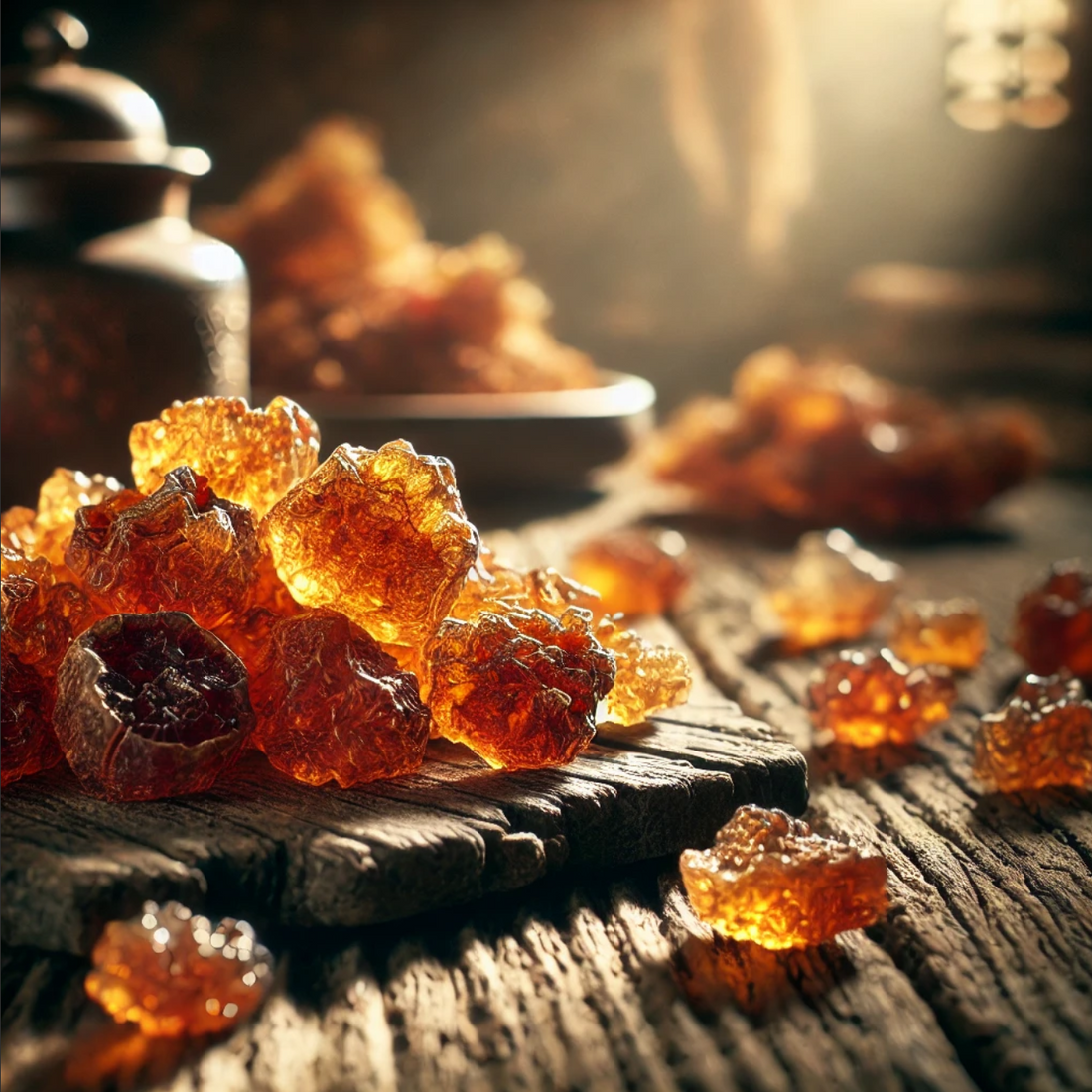
The Ancient Allure of Myrrh: Aroma, History, and Modern Uses in Incense
Share
Myrrh, known for its deep, resinous fragrance, has held a prominent place in spiritual, medicinal, and ceremonial traditions for thousands of years. Derived from the Commiphora myrrha tree, primarily native to the arid landscapes of the Middle East and parts of Africa, myrrh resin is cherished for its warm, earthy, and slightly sweet aroma. This unique scent profile lends itself beautifully to incense, perfumes, and ritualistic uses, providing a grounding and calming presence in any setting.
The Scent of Myrrh: An Enigmatic, Earthy Bouquet
Myrrh's aroma is a complex blend of woody, smoky, and slightly sweet notes that is both grounding and mysterious. The scent is often described as warm and balsamic, with undertones of spice, earthiness, and a touch of bitterness. When burned as incense, myrrh releases a rich, resinous smoke that deepens its warmth, with subtle hints of sweetness reminiscent of caramel or molasses. This distinct fragrance makes it an exceptional choice for creating a tranquil, meditative atmosphere, as well as for adding a layer of aromatic complexity to blended incense and essential oils.
Historical Significance of Myrrh
Ancient Egypt: Sacred and Practical Uses
In ancient Egypt, myrrh was highly valued for both its fragrance and preservative properties. It was used in embalming practices and as a key ingredient in kyphi, an ancient Egyptian incense blend burned in temples. Egyptians also used myrrh in cosmetics and perfumes; Cleopatra is said to have favored myrrh as a key ingredient in her aromatic beauty routines. Myrrh was revered as a “holy resin,” symbolizing purity, immortality, and reverence toward the divine, with records indicating its role in offerings and prayers.
Myrrh in the Bible and Religious Ceremonies
Myrrh's association with divinity is evident in several ancient texts, including the Bible. Alongside frankincense and gold, myrrh was presented as a gift to the infant Jesus, symbolizing respect and sanctity. In the Christian tradition, myrrh represents suffering and sacrifice, frequently symbolizing the mortality of humanity. Myrrh was also a staple in the incense offerings of the Jewish temple and remains integral to the religious practices of many spiritual traditions today, often burned to purify spaces and create a sacred environment for prayer and meditation.
Traditional Medicinal Uses in Ayurveda and Chinese Medicine
In traditional medicinal practices, myrrh has a notable history. In Ayurveda, myrrh is known as “guggul,” used for its anti-inflammatory and rejuvenating properties, while in Traditional Chinese Medicine (TCM), myrrh is utilized to relieve pain, reduce inflammation, and support wound healing. Due to its antimicrobial properties, myrrh has been used for thousands of years to treat ailments such as digestive issues, respiratory problems, and infections.
Why Myrrh is Still Used Today in Incense
In the modern world, myrrh remains a cherished ingredient in incense, valued for its ability to promote tranquility, mindfulness, and a sense of sacredness in any space. Here are some reasons why myrrh continues to be a beloved choice in incense today:
-
Aids Meditation and Spiritual Connection: Myrrh's earthy, grounding scent is ideal for creating a meditative environment, promoting focus, and deepening spiritual practices. The resin is often burned during meditation, yoga, and other mindfulness practices to encourage a calm, centered state and open a channel for spiritual exploration.
-
Purification and Energy Cleansing: Due to its antimicrobial and energetic purifying properties, myrrh incense is widely used to cleanse spaces of negative energies, stagnant emotions, or harmful influences. This practice aligns with ancient uses, where myrrh was burned to purify and protect sacred spaces.
-
Enhances Emotional Balance and Relaxation: Myrrh’s warming and slightly sweet aroma has a grounding effect that supports emotional balance and reduces stress, making it a popular choice in aromatherapy for those seeking to alleviate anxiety or emotional discomfort.
-
Complements Other Aromas in Incense Blends: Myrrh’s complex, resinous aroma blends well with other incense ingredients like frankincense, sandalwood, and cedarwood, enhancing their scents and adding depth. It provides a harmonious base that enriches the fragrance profile of blended incense sticks and cones, often used to create unique, balanced scents ideal for home and ritual use.
How Myrrh is Harvested
The harvesting of myrrh is a delicate process. The Commiphora myrrha tree produces myrrh resin through small incisions made in the bark, allowing the resin to seep out and harden into small, amber-colored droplets over time. The collection process requires patience and skill, as the resin is carefully gathered and preserved for use in incense, essential oils, and medicinal applications.
Myrrh in Modern Wellness and Incense
Today, myrrh is not only found in traditional incense but also in candles, essential oils, and aromatherapy products, where its grounding properties are highly sought after. The resurgence of interest in ancient wellness practices and natural products has brought myrrh back into popular use. Those who burn myrrh incense often do so for its ability to connect them with the past while providing therapeutic benefits that remain relevant in our fast-paced world.
Myrrh, with its storied past and evocative fragrance, offers a sensory journey that transports us to ancient temples, sacred rituals, and timeless traditions. Whether used in meditation, for purifying spaces, or simply to enjoy its warm and earthy aroma, myrrh remains an enduring and beloved component of incense and wellness rituals.


